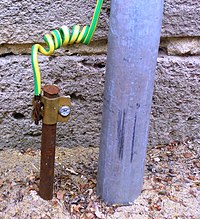
Photo from wikipedia
Abstract The use of an electrically conductive membrane has attracted significant interest in water treatment technology due to remarkable performance in fouling mitigation domain. In electrochemical systems, when external potential… Click to show full abstract
Abstract The use of an electrically conductive membrane has attracted significant interest in water treatment technology due to remarkable performance in fouling mitigation domain. In electrochemical systems, when external potential is applied, water electrolysis occurs and the generated gases efficiently clean the membrane surface. However, fabricating and integrating conductive membranes in current water treatment modules are challenging. The present work applies, for the first time, the electrolysis concept at the spacer component of the module rather than the membrane. Two types of materials were tested, a titanium metal spacer and a polymeric spacer. The polymeric spacer was made conductive via coating with a carbon-based ink comprised of graphene nanoplates (GNPs). A membrane system composed of the carbon coated/titanium metal spacer attached to the surface of a polyvinylidene fluoride (PVDF) microfiltration membrane and was assembled to the case of membrane module. The conductive spacers worked as an electrode (cathode) in electrochemical set-up. The membrane system was subjected to fouling and then exposed to periodic electrolysis, wherein in-situ cleaning of membrane surface by hydrogen bubbles generation at the spacer is applied.
Journal Title: Desalination
Year Published: 2017
Link to full text (if available)
Share on Social Media: Sign Up to like & get
recommendations!